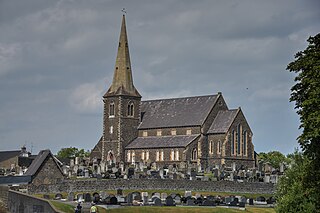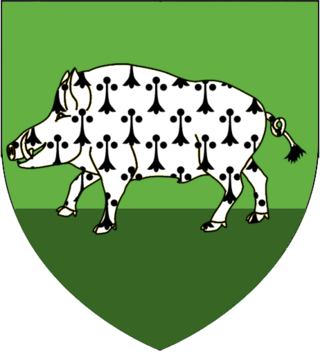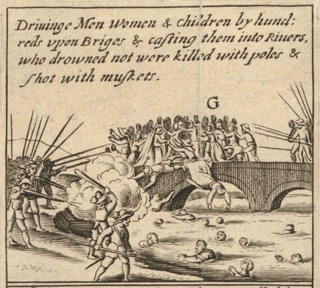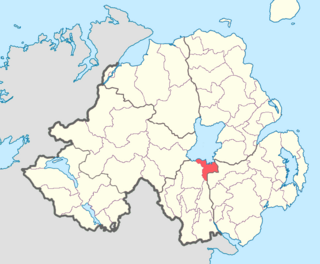
The Mac Cana or Maccan [1] were a Gaelic Irish clan who held lands in Clancann and Clanbrasil in what is now northern County Armagh, and had the title of 'Lords of Clanbrasil'. It is the origin of the surname McCann and Maccan. [2]

The Mac Cana or Maccan [1] were a Gaelic Irish clan who held lands in Clancann and Clanbrasil in what is now northern County Armagh, and had the title of 'Lords of Clanbrasil'. It is the origin of the surname McCann and Maccan. [2]
The name Mac Cana means "son of Cana". This literally means "cub/whelp", and is claimed to be a term for a young warrior. [3]
The Mac Cana originated as chiefs of Cenél Aengusa, the name of a kindred and its territory in Tír Eoghain. [4] In the 12th and 13th centuries they extended their lands along the south of Lough Neagh where they gave their name to the territory of Clancann (Clann Chana), [4] later the barony of Oneilland West. This lay in northern County Armagh between the River Bann and River Blackwater. They also became chiefs of the neighbouring territory of Clanbrassil (Clann Bhreasail), east of the Bann, [4] later the barony of Oneilland East. The main settlement in Clanbrassil, Lurgan, was originally named Lorgain Bhaile Mhic Cana ("ridge of Mac Cana's townland"). [4] Nearby Portadown (Port an Dúnáin) is believed to be named after a fort of the Mac Cana. [5] An English map from the early 1600s shows a prominent house at Maghery in Clancann, which was probably the last residence of the Mac Cana chiefs. [6]
The Mac Cana and their neighbours were vassals of the powerful O'Neill dynasty of Tyrone. During the Nine Years' War (1594–1603), the O'Neills and their allies fought against English expansion in Ireland. Following the English victory and Flight of the Earls, the English seized the lands of the O'Neills and their allies. This would seem to include the Mac Cana. This land was colonized by English-speaking Protestant settlers from Britain, during the plantation of Ulster. [5]
During the Irish Rebellion of 1641, the Mac Cana re-took Lurgan and Portadown from the settlers. [5] Irish rebels killed about 100 captured British settlers at Portadown by forcing them off the bridge into the River Bann, and shooting those who tried to swim to safety. Known as the Portadown massacre, it was the biggest such massacre during the rebellion. The rebels were likely under the command of Toole McCann. [7] Following the Irish Confederate Wars and Cromwellian conquest of Ireland, the area was re-taken by the English. Toole McCann was captured and executed by English forces in 1653, although he denied ordering the massacre. [8]
Under the Act for the Settlement of Ireland 1652, Irish rebels and many native Irish Catholics lost most of their land. Some were given poorer lands in Connaught or County Clare, and others were exiled from Ireland. This may be the origin of the McGanns, an anglicised Connaught variant of 'Mac Cana'. [9]
Due to anglicization the original form Mac Cana has had many different variations, such as McGann, MacCann, MacCan, Maccan, MacCana, and became Canny and Canney upon Ulster migration to the south (Leinster and Munster). [10]

County Armagh is one of the six counties of Northern Ireland and one of the traditional thirty-two counties of Ireland. It is located in the province of Ulster and adjoins the southern shore of Lough Neagh. It borders the Northern Irish counties of Tyrone to the west and Down to the east. The county borders Louth and Monaghan to the south and southwest, which are in the Republic of Ireland. It is named after its county town, Armagh, which derives from the Irish Ard Mhacha, meaning "Macha's height". Macha was a sovereignty goddess in Irish mythology and is said to have been buried on a wooded hill around which the town of Armagh grew. County Armagh is colloquially known as the "Orchard County" because of its many apple orchards.
Lurgan is a town in County Armagh, Northern Ireland, near the southern shore of Lough Neagh and roughly 18 miles (29 km) southwest of Belfast. The town is linked to Belfast by both the M1 motorway and the Belfast–Dublin railway line. Lurgan had a population of about 28,634 at the 2021 UK census, and falls within the Armagh, Banbridge and Craigavon district. For certain purposes, Lurgan is treated as part of the "Craigavon Urban Area", along with neighbouring Craigavon and Portadown.

Portadown is a town in County Armagh, Northern Ireland. The town sits on the River Bann in the north of the county, about 24 miles (39 km) southwest of Belfast. It is in the Armagh City, Banbridge and Craigavon Borough Council area and had a population of about 32,000 at the 2021 Census. For some purposes, Portadown is treated as part of the "Craigavon Urban Area", alongside Craigavon and Lurgan.

Drumcree Parish Church, officially The Church of the Ascension, is the Church of Ireland parish church of Drumcree in County Armagh, Northern Ireland. It sits on a hill in the townland of Drumcree, outside Portadown. It is a site of historic significance and is a listed building.

Loughgall is a small village, townland and civil parish in County Armagh, Northern Ireland. It is in the historic baronies of Armagh and Oneilland West. It had a population of 282 people in the 2011 Census. Loughgall was named after a small nearby loch. The village is surrounded by orchards.

The Ó h-Anluain family was an agnatic extended family comprising one of a string of dynasts along the Ulster-Leinster border. Depending on the advantage to the clan, the Chief of the Name—The O'Hanlon—supported either the Earl of Tyrone or authorities within the English Pale. During the 15th century, ties were close with the famed Earls of Kildare. Frequently, members of the clan would fight on both sides during a rebellion. Some would be outlawed; others pardoned; some ending up on the winning side.
McCann or MacCan is an Irish surname. It is derived from the Gaelic Mac Cana meaning "son of Cana". The Irish given name Cana literally means "cub", specifically alluding to a "wolf cub". The Mac Cana were a Gaelic Irish clan who held the lands of Clancann and Clanbrassil, together known as Oneilland, in what is now northern County Armagh. The surname is strongly associated with that part of Ulster.

Clandeboye or Clannaboy was a kingdom of Gaelic Ireland, comprising what is now south County Antrim, north County Down, and the barony of Loughinsholin. The entity was relatively late in appearance and is associated partly with the Gaelic resurgence of the High Middle Ages. The O'Neill Clandeboy who reigned in the territory descended from Hugh Boy O'Neill, a king of Tyrone. His descendants took advantage of the demise of the Earldom of Ulster during the latter 14th century and seized vast portions of territory. Clandeboye's main seats of power were Shane's Castle and Castle Reagh.
Garvey and O'Garvey are Irish surnames, derived from the Gaelic Ó Gairbhith, also spelt Ó Gairbheith, meaning "descendant of Gairbhith". Gairbhith itself means "rough peace".

The O'Neill dynasty are a lineage of Irish Gaelic origin that held prominent positions and titles in Ireland and elsewhere. As kings of Cenél nEógain, they were historically one of the most prominent family of the Northern Uí Néill, along with the O'Donnell dynasty. Some O'Neills state that their ancestors were kings of Ailech during the Early Middle Ages, as descendants of Niall of the Nine Hostages.

The Portadown massacre took place in November 1641 at Portadown, County Armagh, during the Irish Rebellion of 1641. Irish Catholic rebels, likely under the command of Toole McCann, killed about 100 Protestant settlers by forcing them off the bridge into the River Bann and shooting those who tried to swim to safety. The settlers were being marched east from a prison camp at Loughgall. This was the biggest massacre of Protestants during the rebellion, and one of the bloodiest during the Irish Confederate Wars. The Portadown massacre, and others like it, terrified Protestants in Ireland and Great Britain, and were used to justify the Cromwellian conquest of Ireland and later to lobby against Catholic rights.
Presented below is a chronology of the major events of the Irish Confederate Wars from 1641 to 1653. This conflict is also known as the Eleven Years War. The conflict began with the Irish Rebellion of 1641 and ended with the Cromwellian conquest of Ireland (1649–53).
The McDonnells of Cnoc na Cloiche,, better known to the Irish as Mac Domhnáill Gallogáigh, are an Irish Gallowglass clan and a branch of Clan Donald who were located in Knocknacloy, County Tyrone. They no longer have a clan chief and are not recognized by the Court of the Lord Lyon.

Oneilland is the name of a former barony in County Armagh, present-day Northern Ireland. It covers the northern area of the county bordering the south-eastern shoreline of Lough Neagh. At some stage the barony was divided into Oneilland East and Oneilland West.

Oneilland West is a barony in County Armagh, Northern Ireland. It is also called Clancann, after the Mac Cana clan. It lies in the north of the county on the south-western shore of Lough Neagh and the border of County Tyrone. Oneilland West is bordered by five other baronies: Armagh to the west; Dungannon Middle to the north-west; Oneilland East to the north-east; Orior Lower to the south-east; and Kinelarty to the south.

Oneilland East is a barony in the north-east of County Armagh, Northern Ireland. It is also called Clanbrasil. It lies in the north-east corner of the county, on the south-eastern shore of Lough Neagh and the boundary with County Down. Oneilland East is bordered by three other baronies: Oneilland West to the west; Iveagh Lower to the east; and Orior Lower to the south.

The Northern Uí Néill was any of several dynasties in north-western medieval Ireland that claimed descent from a common ancestor, Niall of the Nine Hostages. Other dynasties in central and eastern Ireland who also claimed descent from Niall are termed the Southern Uí Néill. The dynasties of the Northern Uí Néill were the Cenél Conaill and Cenél nEógain, named after the two most powerful sons of Niall: Conall and Eógain.
The Cenél nEógain or Kinel-Owen are a branch of the Northern Uí Néill, any of several dynasties in north-western medieval Ireland. They claim descent from Eógan mac Néill, son of Niall of the Nine Hostages. Originally their power-base was in Inishowen, with their capital at Ailech, in modern-day County Donegal in what is now the west of Ulster. Under pressure from the Cenél Conaill, they gradually spread their influence eastwards into modern counties Tyrone and Londonderry, pushing aside the Cruithin east of the River Bann, and encroaching on the Airgiallan tribes west of Lough Neagh. By the 11th century their power-base had moved from Ailech to Tullyhogue outside Cookstown, County Tyrone. By the 12th century the Cenél Conaill conquered Inishowen; however, it mattered little to the Cenél nEóghain as they had established a powerful over-kingdom in the east that had become known as Tír Eoghain, or the "Land of Owen", preserved in the modern-day name of County Tyrone.